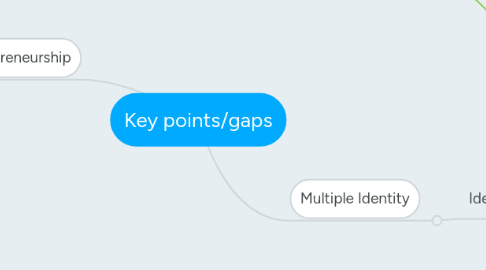
1. Entrepreneurship
1.1. Replicate Essers & Bishop study
1.1.1. focus on a neglected group of entrepreneurs makes for a contribution to the deconstruction of the entrepreneurial archetype of the UNIVERSITY DROP OUT (instead of white male entrepreneur)
1.1.2. - social constructionist and/or discursive approaches to entrepreneurship are rare but do call attention to entrepreneurial identities (Steyaert and Hjorth 2003) Essers
1.1.3. - Lack of knowledge of multiple identity being part of the entrepreneurial process (Essers & Bishop)
1.1.3.1. backup by Nielsen & Lassen
1.1.4. lack of research on identities of entrepreneurs whereas "organisational identity" is a mature topic
1.2. My own perspective
1.2.1. Displaying Entrepreneurial Mindset?
1.2.1.1. maybe "divergent students"?
1.2.1.2. part of Enpreneurial process?
1.2.1.2.1. Ability to sense, act, and mobilise under certain conditions (Ireland et al. 2003)
1.2.2. Entrepreneurial process
1.2.2.1. identify Studentpreneurs if they match the process
1.2.2.2. Need to review lit on entrepreneurial process
1.2.2.3. Entrepreneurial Journey
1.2.3. Identities
1.2.3.1. Young
1.2.3.2. Student
1.2.3.3. Entrepreneur
1.2.4. Australian sample
1.2.4.1. Culturally diverse
1.3. Contributions
1.3.1. Further understanding of identity creation being part of the entrepreneurial journey
1.3.1.1. especially the beginng that is not well known
1.3.2. Strategies for managing multiple identities
1.3.2.1. successfully for entrpeneur
2. Multiple Identity
2.1. Identity Work/Construction
2.1.1. Identity is socially constructed
2.1.1.1. Not a gap
2.1.1.1.1. identity as a process of becoming (Giddens, 1991)
2.1.1.1.2. emerging consensus that identity is constituted through interaction between the individual, society and culture.
2.1.1.1.3. There is shared agreement that identities are multiple, mutable, and socially constructed (Baumeister, 1998; Cooley, 1902; Goffman, 1959; Mead, 1934
2.1.2. identity social construction leads to multiple identity.
2.1.3. Use of the narrative to build identity
2.1.3.1. Very interesting but not too sure where are the gaps
2.1.3.2. importance of narrative and interaction with stakeholders
2.1.3.3. narrative forms of expressing and claiming identity have not received adequate attention in organizational research (Ibarra 2010)
2.1.4. Managing Multiple Identity
2.1.4.1. use intersectionality as multiple identity conflict/management
2.1.4.1.1. intersection of student and entrepreneurial identities. Lived practices show that identity is constructed at the intersection
2.1.4.1.2. furthers intersectionality studies that until now (Essers & B. 2007) have rarely been conducted in organizational and entrepreneurial setting: it's about managing conflict
2.1.4.1.3. notions of intersectionality provide a better understanding of entrepreneurship (Essers 2010)
2.1.4.1.4. We use the notion of intersectionality to make sense of these multiple identities. (Essers 2010)
2.1.4.2. micropolitics of identity construction in a context where identities are salient and contested at the same time: that's could be my gap too (contribution from Essers & Bishop)
2.1.5. Less distinction between
2.1.5.1. public social identity
2.1.5.2. personal social identity
2.1.5.2.1. Is it really a gap?
2.1.6. Identitification from Ashforth
2.1.6.1. process as a cycle that iterates between organizational sensebreaking and sensegiving and individual identity enactment, sensemaking, and identity narrative construction.
2.1.6.1.1. He encourages further research on the speculative model
2.1.6.1.2. Identification to organisation is different from identity construction but the model could apply to identity construction.
2.1.7. Strategies to build multiple identities
2.1.7.1. The practices and strategies by which people craft and negotiate work identities are at the heart of a burgeoning stream of research (Ibarra 2010)
